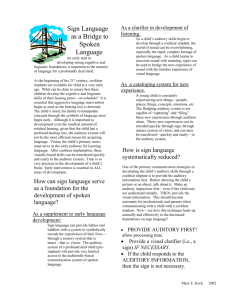No Slide Title - Auditory Verbal Training
advertisement
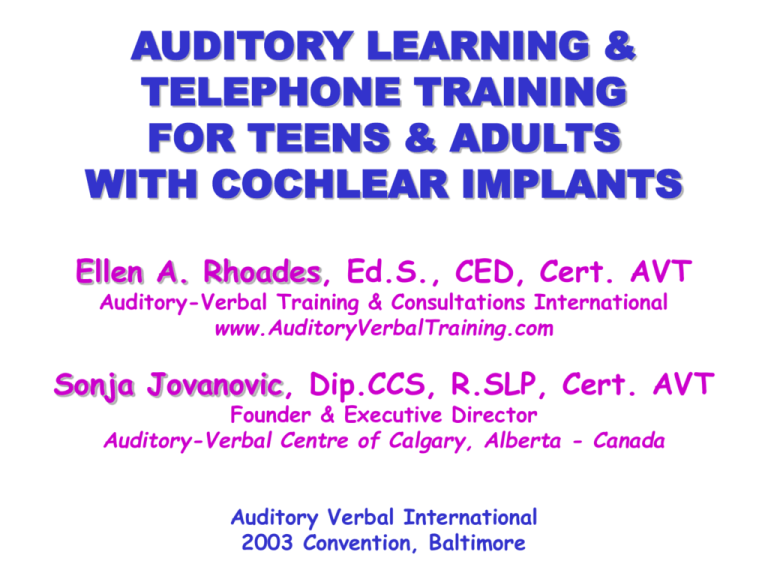
AUDITORY LEARNING & TELEPHONE TRAINING FOR TEENS & ADULTS WITH COCHLEAR IMPLANTS Ellen A. Rhoades, Ed.S., CED, Cert. AVT Auditory-Verbal Training & Consultations International www.AuditoryVerbalTraining.com Sonja Jovanovic, Dip.CCS, R.SLP, Cert. AVT Founder & Executive Director Auditory-Verbal Centre of Calgary, Alberta - Canada Auditory Verbal International 2003 Convention, Baltimore A COMPREHENSIVE AURAL REHABILITATION PROGRAM > Pre-Ops > Counseling & Self-discovery > Equipment > Social Interaction Strategies > Education (information) > Aural Rehabilitation Approaches > Therapy Activities > Listening-Speech Techniques > Telephone Training Strategies > Resources (synthetic & analytic) REHABILITATIONIST’S ROLES The Brass Ring • FACILITATOR • EDUCATOR • COUNSELOR • ENABLER • MOTIVATOR • TEMPTRESS • PUSHER • THERAPIST The Holy Grail The Beacon PSYCHOSOCIAL CANDIDACY • • • • • • • Has the teen/adult ‘accepted’ deafness….or still grieving or in denial? Who is the main player – the teen/adult or the parent/spouse? Why does the teen/adult want the implant? Are the teen/adult’s friends Deaf or culturally hearing? Does the teen/adult wear hearing aids, intermittently/permanently? Is hearing or speaking a priority in the teen/adult’s daily life? Are the teen/adult’s CI hoped-for outcomes realistic? Therapist listens for: • What kind of language does the person use to describe the current situation due to deafness? What is the severity of the person’s language dysfunction, if any? • How does the person describe the CI? Can the person give a fairly good description of how it works? • Is the person’s speech intelligible? Is voice quality within normal limits? To what degree does the candidate rely on signs? ASSESSMENT TOOLS • Preliminary Questionnaire: provides information on the person’s history, self-perception of hearing loss and hearing aid benefits • Expectations Questionnaire: for the CI candidate and a parent/spouse/friend; often accompanied by an oral interview • “Why I Want A Cochlear Implant”: a one-page essay written by the candidate provides insight into person’s language and expected outcomes of CI • Functional Auditory Discrimination Assessment: informal evaluation of candidate’s listening skills; provides a preimplant baseline of person’s use of residual hearing AUDITORY DISCRIMINATION ASSESSMENT • high - low (pitch) • loud - soft (intensity) • long - short (duration) • emotional content (angry, happy, sad) • number of syllables • sentence length variations • sentence suprasegmentals (statement, query, exclamation) • high vs low frequency speech sounds • auditory tracking Determine Auditory Weaknesses: move from GROSS SUBTLE in follow-up listening activities (auditory discrim) activities ASSESSMENT FINDINGS • Preferred Mode of Communication • Speech Production Skills & Voice Parameters • Language Skills • Social Skills • Psychosocial Issues • Motivation & Expectations • Reliability in attendance BEFORE HEARING • Surgery is scheduled • Counseling continues A. Social interaction strategies B. Education (information) CI candidate starts the road to self-discovery • Discuss what will happen during surgery • Discuss what will happen during initial stim or “turn-on” • Review of CI equipment WHY SOME ANALYTIC STRATEGIES? • Allows the CI user to analyze and visualize the basic sounds of speech • Gives meaning to CI user’s descriptions of perceived ‘noises’ interfering with speech • Encourages self-monitoring of the CI user’s own speech • Indicates some of the difficulties with speechreading & the benefits of listening • Provides some success at listening to motivate and encourage. SYNTHETIC STRATEGIES (Discrimination of total units: personalized sentences & connected discourse) Meaningful w/ general comprehension (pointing/imitation) acceptable Rhythmic auditory-speech tracking w/ timely reading material (e.g., cupacoffee) Poems, songs, rhymes (Three blind mice, Frere Jacques) a la ronde (in the round) Sentences varied in length, vowels, syllables, intonation Numeral confusions repair strategies include counting to correct # Sound confusions repair strategies include code wds and reciting alphabet string Alphabet-word association list Topical (related unrelated) DON’T FORGET THE MAP Quarterly mapping initially At least annual maps thereafter Watch out for indicators that upgrades may be needed in between: • • • • headaches bad moods fatigue not wearing the processor at all times HEARING COMPLAINTS “I hear constant echoes and buzzing!” Use both synthetic and analytic strategies to determine specific speech perception errors or interference occurrences. Work with CI audiologist to adjust settings and reduce effects Are high frequency phonemes clear enough or do they sound like noise? Do T or C levels, IDR, RF, or gain need to be adjusted? Does CI user need to re-learn what soft-loud-too loud (perception of intensity gradients)? THE INQUIRING THERAPIST Ask questions: • • • • • • • • • • Did the homework assignment provide stress for you? Do you still have problems understanding others? How do you awaken each morning when you travel? Which listening situations are hardest for you? What do you think of your mother interpreting for you? Why does that make you angry? How do you feel about people exaggerating when they talk to you? Who helps you the most? How did you do with your homework this past week? Did you learn anything today? LISTEN LISTEN LISTEN LISTEN LISTEN LISTEN LISTEN LISTEN LISTEN THERAPISTS SHOULD... Lurk on a CI online group for 6 months. CI@YORK.CA Hear their concerns. Listen to their voices. THE AUDITORY SANDWICH Visual cues: • lip-reading • printed word • cued speech • signs HEAR SEE - SAY HEAR-UNDERSTAND First, listen. Then, if need be, watch or say it. Then, listen again (no visual cues) Always put it back into hearing! ALL-INCLUSIVE THERAPY Use both analytic AND synthetic approaches Employ global conversational skills Daily rhythmical activities; use metronome as needed Somewhat easy AND difficult training exercises per session Daily listening sessions: the ‘auditory sandwich’ Daily informal listening activities Develop effective hearing tactics too! Listen to client: practice-progress-perspectives (counseling) Intellectualize the program; ‘force’ teen to “think” the word Interweave the development of speech, listening skills, & psychosocial skills BASIC TRAINING Practice taking messages for other family members Simple content (phone numbers only) More difficult content (addresses and extended messages) More difficult speech delivery (force use of repair strategies) Listen repeatedly to recorded messages, e.g. calling movie theatres, weather, answering machines Practice calling parents and selected friends with 20-30 pre-written sentences General conversation! COMMON CHARACTERISTICS OF “GOOD COPERS” • BE DOMINANT: show assertive behavior; act on your own best interests; promote equality in relationships; stand up for yourself; exercise personal rights while respecting others. • BE EXPEDIENT: use whatever is necessary to achieve a specific goal...any means to the end. • BE FORTHRIGHT: be unpretentious, open, direct, straightforward with others. Be DEF Research findings of L. Glass & H. Elliot MINIMAL HOMEWORK • AUDITORY TRACKING (live speech with newspapers; audiotaped library books; web sites) • ALPHABET WORD LIST (family/friends) • CLOSED SETS (phone: questions & answers) • TOPICAL SENTENCES (family/friends) • TELEPHONE PRACTICE! Use videotapes, partners, notes, phone calls for carryover. Whatever works is effective! READINGS Biderman, B. (1998). Wired for sound Farley, C. (2003). Bridge to sound with a ‘bionic’ ear Romoff, A. (2000). Hear again Weber, D. T. (1999). Journey out of silence Erber, N. (1996). Communication therapy for adults w/ sensory loss Koch, M. (1999). Bringing sound to life Plant, G. (1999). Hear at home: A home training program for adults with hearing loss Rezen, S. & Hausman, C. (2000). Coping with hearing loss: Plain talk for adults Tye-Murray, N. (1997). Communication training for older teenagers and adults: Listening, speechreading, and using conversational strategies Wayner, D. & Abrahamson, J. (2001). Learning to hear again with a cochlear implant Some professional researchers: Gagne, Owens, Trychin, Caissie MORE RESOURCES http://www.AuditoryVerbalTraining.com http://www.focusonhearing.org http://www.saywhatclub.com http://www.hearingloss.com http://www.listen-up.org CI@yorku.ca (online forum) SHHH ALDA CIAI A.G. Bell AVI

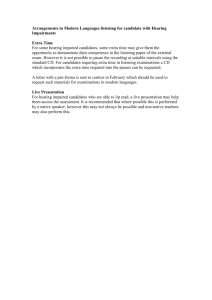

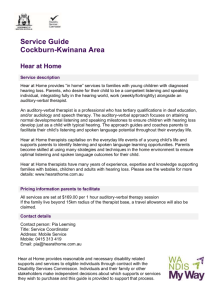
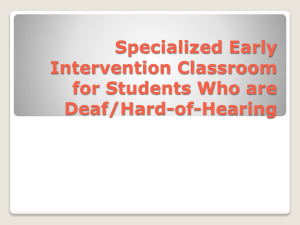
![to Learning Styles Questionnaire [MS Word,93Kb]](http://s3.studylib.net/store/data/007287401_2-741c6340dee171d22423967f2d0c2716-300x300.png)

